Multi-User Joint Detection Using Bi-Directional Deep Neural Network Framework in NOMA-OFDM System
Abstract
1. Introduction
- Multiuser uplink CE and signal detection for NOMA-OFDM wireless communication is considered. The CE and signal detection is performed by the proposed Bi-LSTM model over the Rayleigh fading channel.
- The proposed Bi-LSTM model can jointly estimate and detect the transmission data from multiple UE signals directly instead of the traditional SIC method.
- To observe the effectiveness of the proposed model, a comparative analysis of convolutional neural network (CNN) and the proposed model in terms of SER is performed.
- Using the Monte Carlo simulation, the SER performance of Bi-LSTM is evaluated in terms of different SNR. It is observed that the performance of the proposed model is comparable to the outage performance of the conventional NOMA-SIC methods, including least square (LS) and minimum mean square error (MMSE) and CNN model.
2. Related Works
3. System Model
3.1. Signal and Channel Model
3.2. Problem Illustration
4. Proposed Deep-Learning Model
4.1. Data Generation
4.2. Model Architecture
4.2.1. Network Description
4.2.2. Internal Structure of LSTM
4.2.3. Offline Training and Online Testing Operation of the Model
| Algorithm 1 BiLTSM Training Process |
|
4.2.4. Testing Process
5. Simulation Results and Discussion
5.1. Performance Evaluation
5.2. Simulations Results
5.3. Complexity Analysis
6. Conclusions
Author Contributions
Funding
Institutional Review Board Statement
Informed Consent Statement
Data Availability Statement
Conflicts of Interest
References
- Dai, L.; Wang, B.; Yuan, Y.; Han, S.; Chih-Lin, I.; Wang, Z. Non-orthogonal multiple access for 5G: Solutions, challenges, opportunities, and future research trends. IEEE Commun. Mag. 2015, 53, 74–81. [Google Scholar] [CrossRef]
- Chettri, L.; Bera, R. A Comprehensive Survey on Internet of Things (IoT) Toward 5G Wireless Systems. IEEE Internet Things J. 2020, 7, 16–32. [Google Scholar] [CrossRef]
- Akbar, A.; Jangsher, S.; Bhatti, F.A. NOMA and 5G emerging technologies: A survey on issues and solution techniques. Comput. Netw. 2021, 190, 107950. [Google Scholar] [CrossRef]
- Budhiraja, I.; Kumar, N.; Tyagi, S.; Tanwar, S.; Han, Z.; Piran, M.J.; Suh, D.Y. A systematic review on NOMA variants for 5G and beyond. IEEE Access 2021, 9, 85573–85644. [Google Scholar] [CrossRef]
- Thirunavukkarasu, R.; Balasubramanian, R. An efficient code domain NOMA scheme with enhanced spectral and energy efficiency for networks beyond 5G. Wirel. Pers. Commun. 2021, 120, 353–377. [Google Scholar] [CrossRef]
- Liu, Y.; Qin, Z.; Elkashlan, M.; Ding, Z.; Nallanathan, A.; Hanzo, L. Non-orthogonal multiple access for 5G and beyond. Proc. IEEE 2017, 105, 2347–2381. [Google Scholar] [CrossRef]
- Islam, S.R.; Avazov, N.; Dobre, O.A.; Kwak, K.S. Power-domain non-orthogonal multiple access (NOMA) in 5G systems: Potentials and challenges. IEEE Commun. Surv. Tutor. 2016, 19, 721–742. [Google Scholar] [CrossRef]
- Choi, J. Minimum power multicast beamforming with superposition coding for multiresolution broadcast and application to NOMA systems. IEEE Trans. Commun. 2015, 63, 791–800. [Google Scholar] [CrossRef]
- Sejan, M.A.S.; Rahman, M.H.; Shin, B.S.; Oh, J.H.; You, Y.H.; Song, H.K. Machine Learning for Intelligent-Reflecting-Surface-Based Wireless Communication towards 6G: A Review. Sensors 2022, 22, 5405. [Google Scholar] [CrossRef]
- Morocho-Cayamcela, M.E.; Lee, H.; Lim, W. Machine learning for 5G/B5G mobile and wireless communications: Potential, limitations, and future directions. IEEE Access 2019, 7, 137184–137206. [Google Scholar] [CrossRef]
- Sejan, M.A.S.; Rahman, M.H.; Song, H.K. Demod-CNN: A Robust Deep Learning Approach for Intelligent Reflecting Surface-Assisted Multiuser MIMO Communication. Sensors 2022, 22, 5971. [Google Scholar] [CrossRef]
- Wang, X.; Zhu, P.; Li, D.; Xu, Y.; You, X. Pilot-assisted SIMO-NOMA signal detection with learnable successive interference cancellation. IEEE Commun. Lett. 2021, 25, 2385–2389. [Google Scholar] [CrossRef]
- Chen, W.; Tang, Z. Research on improved receiver of NOMA-OFDM signal based on deep learning. In Proceedings of the 2021 IEEE International Conference on Communications, Information System and Computer Engineering (CISCE), Beijing, China, 14–16 May 2021; pp. 173–177. [Google Scholar]
- Sim, I.; Sun, Y.G.; Lee, D.; Kim, S.H.; Lee, J.; Kim, J.H.; Shin, Y.; Kim, J.Y. Deep learning based successive interference cancellation scheme in nonorthogonal multiple access downlink network. Energies 2020, 13, 6237. [Google Scholar] [CrossRef]
- Lin, C.; Chang, Q.; Li, X. A deep learning approach for MIMO-NOMA downlink signal detection. Sensors 2019, 19, 2526. [Google Scholar] [CrossRef]
- Zhu, P.; Wang, X.; Jia, X.; Xu, Y. Deep Learning-Based Signal Detection with Soft Information for MISO-NOMA Systems. In Proceedings of the 2021 IEEE 94th Vehicular Technology Conference (VTC2021-Fall), Norman, OK, USA, 27–30 September 2021; pp. 1–5. [Google Scholar]
- Kumar, A.; Kumar, K. Deep Learning-based Joint NOMA Signal Detection and Power Allocation in Cognitive Radio Networks. IEEE Trans. Cogn. Commun. Netw. 2022, 2022, 3193389. [Google Scholar] [CrossRef]
- Zhang, N.; Cheng, K.; Kang, G. A machine-learning-based blind detection on interference modulation order in NOMA systems. IEEE Commun. Lett. 2018, 22, 2463–2466. [Google Scholar] [CrossRef]
- Yin, Z.; Chen, J.; Li, G.; Wang, H.; He, W.; Ni, Y. A Deep Learning-Based User Selection Scheme for Cooperative NOMA System with Imperfect CSI. Wirel. Commun. Mob. Comput. 2022, 2022, 7732029. [Google Scholar] [CrossRef]
- Huang, H.; Yang, Y.; Ding, Z.; Wang, H.; Sari, H.; Adachi, F. Deep learning-based sum data rate and energy efficiency optimization for MIMO-NOMA systems. IEEE Trans. Wirel. Commun. 2020, 19, 5373–5388. [Google Scholar] [CrossRef]
- Kang, J.M.; Kim, I.M.; Chun, C.J. Deep learning-based MIMO-NOMA with imperfect SIC decoding. IEEE Syst. J. 2019, 14, 3414–3417. [Google Scholar] [CrossRef]
- Coleri, S.; Ergen, M.; Puri, A.; Bahai, A. Channel estimation techniques based on pilot arrangement in OFDM systems. IEEE Trans. Broadcast. 2002, 48, 223–229. [Google Scholar] [CrossRef]
- Liu, W.; Lin, W. Additive white Gaussian noise level estimation in SVD domain for images. IEEE Trans. Image Process. 2012, 22, 872–883. [Google Scholar] [CrossRef]
- Xie, Y.; Teh, K.C.; Kot, A.C. Deep learning-based joint detection for OFDM-NOMA scheme. IEEE Commun. Lett. 2021, 25, 2609–2613. [Google Scholar] [CrossRef]
- Le Ha, A.; Van Chien, T.; Nguyen, T.H.; Choi, W. Deep learning-aided 5G channel estimation. In Proceedings of the 2021 IEEE 15th International Conference on Ubiquitous Information Management and Communication (IMCOM), Seoul, Korea, 4–6 January 2021; pp. 1–7. [Google Scholar]
- Bai, Q.; Wang, J.; Zhang, Y.; Song, J. Deep learning-based channel estimation algorithm over time selective fading channels. IEEE Trans. Cogn. Commun. Netw. 2019, 6, 125–134. [Google Scholar] [CrossRef]
- Chen, P.; Kobayashi, H. Maximum likelihood channel estimation and signal detection for OFDM systems. In Proceedings of the 2002 IEEE International Conference on Communications. Conference Proceedings. ICC 2002 (Cat. No. 02CH37333), New York, NY, USA, 28 April–2 May 2002; Volume 3, pp. 1640–1645. [Google Scholar]
- Aldababsa, M.; Toka, M.; Gökçeli, S.; Kurt, G.K.; Kucur, O. A tutorial on nonorthogonal multiple access for 5G and beyond. Wirel. Commun. Mob. Comput. 2018, 2018, 9713450. [Google Scholar] [CrossRef]
- Hameed, Z.; Garcia-Zapirain, B. Sentiment classification using a single-layered BiLSTM model. IEEE Access 2020, 8, 73992–74001. [Google Scholar] [CrossRef]
- Schuster, M.; Paliwal, K.K. Bidirectional recurrent neural networks. IEEE Trans. Signal Process. 1997, 45, 2673–2681. [Google Scholar] [CrossRef]
- Hochreiter, S.; Schmidhuber, J. Long short-term memory. Neural Comput. 1997, 9, 1735–1780. [Google Scholar] [CrossRef]
- Bengio, Y. Learning deep architectures for AI. Found. Trends Mach. Learn. 2009, 2, 1–127. [Google Scholar] [CrossRef]
- Kingma, D.P.; Ba, J. Adam: A method for stochastic optimization. arXiv 2014, arXiv:1412.6980. [Google Scholar]
- Le, X.H.; Ho, H.V.; Lee, G.; Jung, S. Application of long short-term memory (LSTM) neural network for flood forecasting. Water 2019, 11, 1387. [Google Scholar] [CrossRef]
- Ahn, Y.; Kim, W.; Shim, B. Active user detection and channel estimation for massive machine-type communication: Deep learning approach. IEEE Internet Things J. 2021, 9, 11904–11917. [Google Scholar] [CrossRef]
- Zhu, Y.; Wang, B.; Xie, F.; Wu, C.; Chao, P. Data-Driven Signal Detection for Underwater Acoustic Filter Bank Multicarrier Communications. Wirel. Commun. Mob. Comput. 2022, 2022, 4943442. [Google Scholar] [CrossRef]

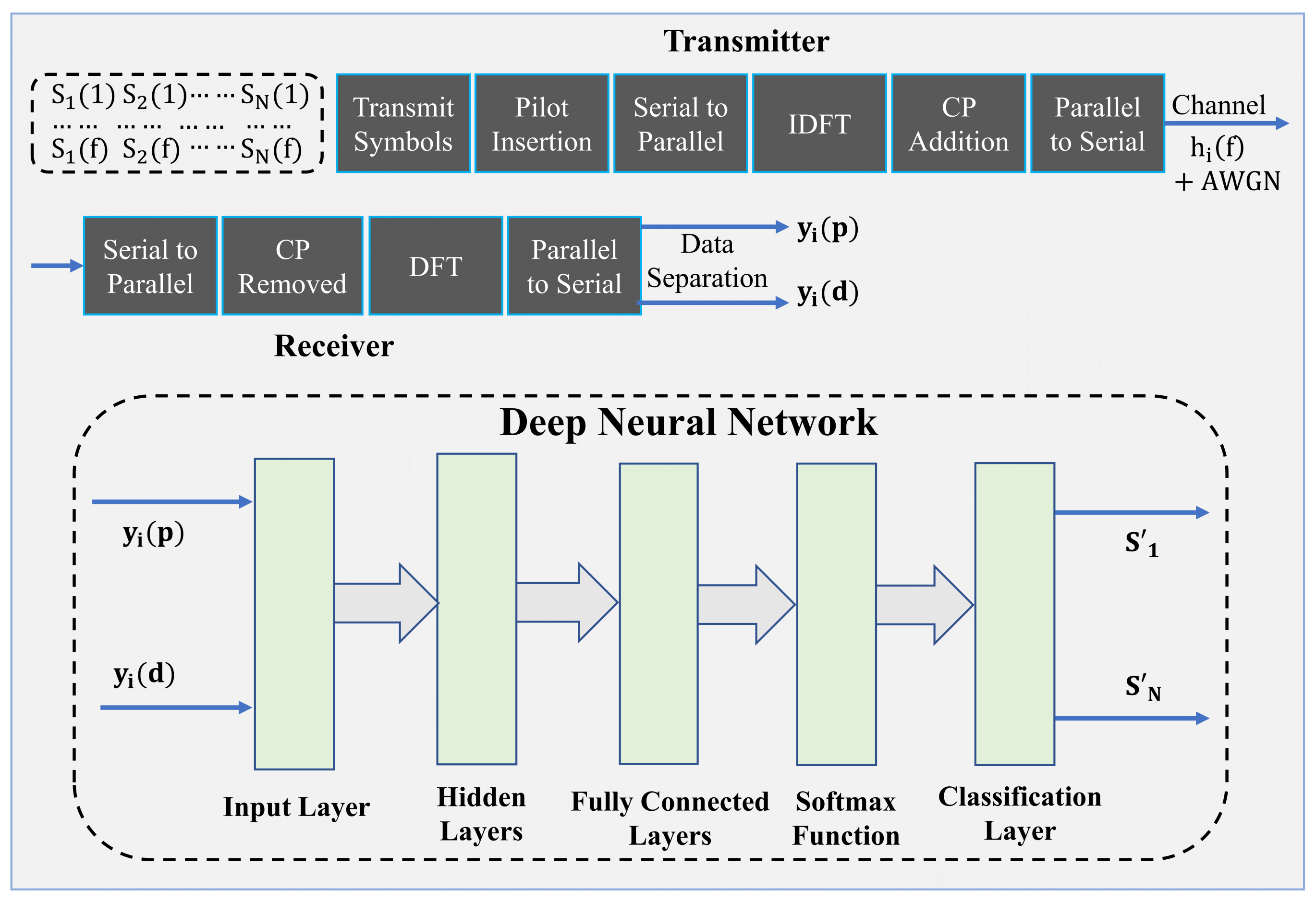
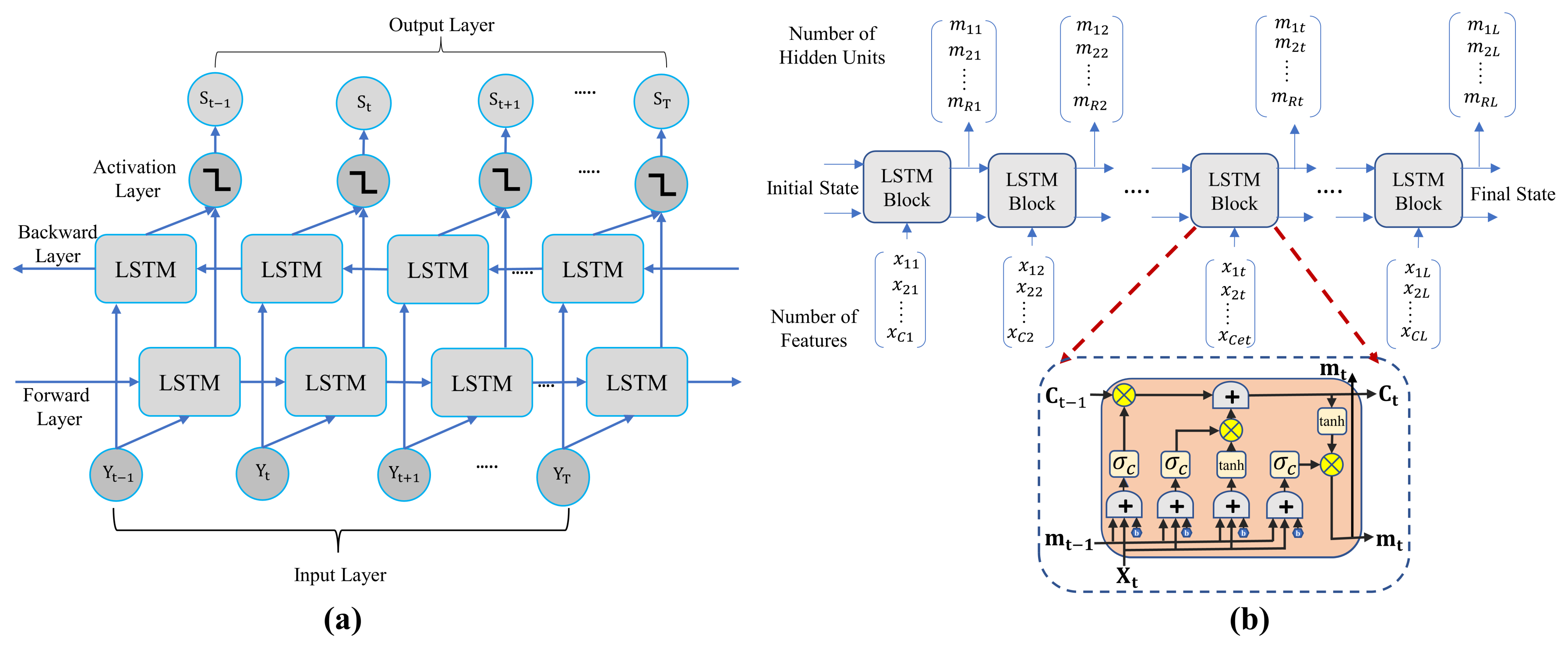
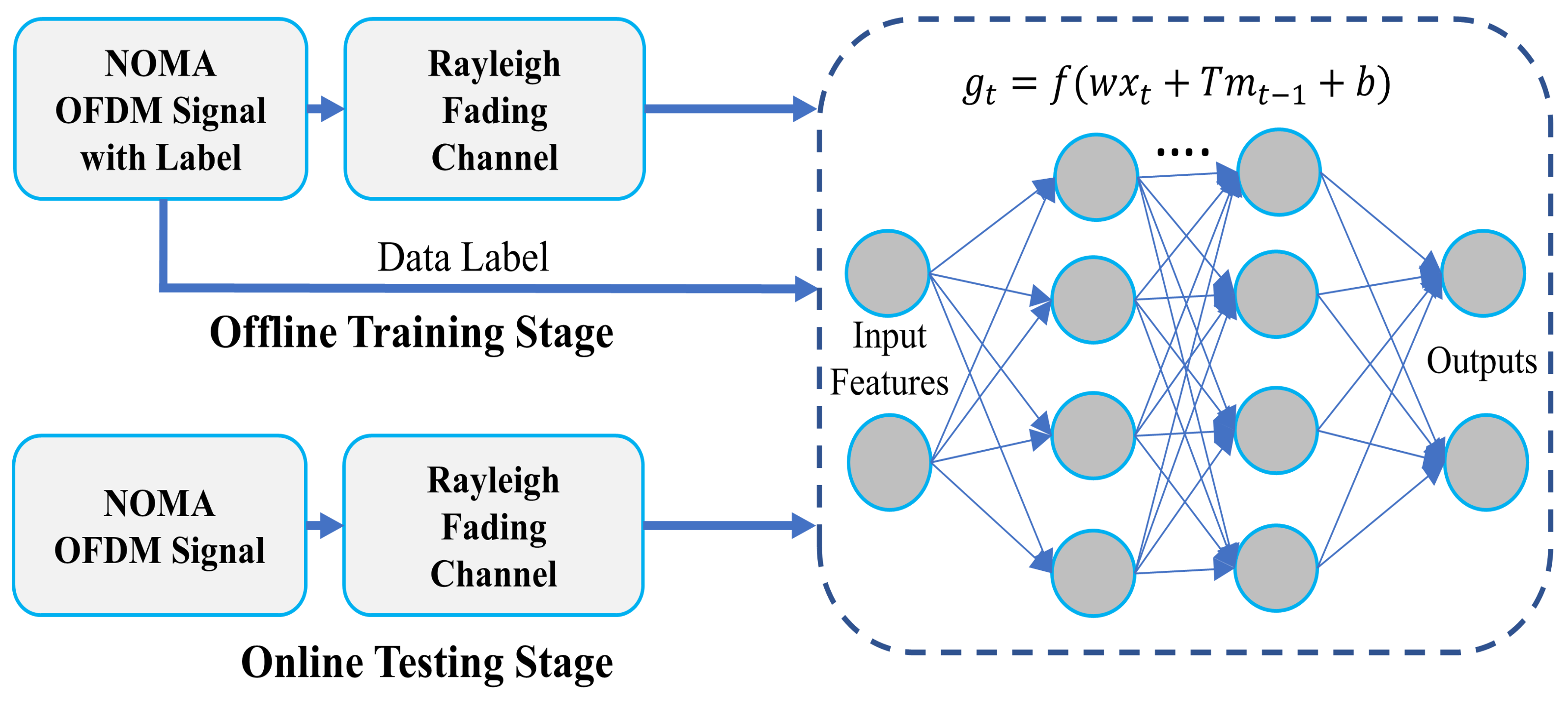

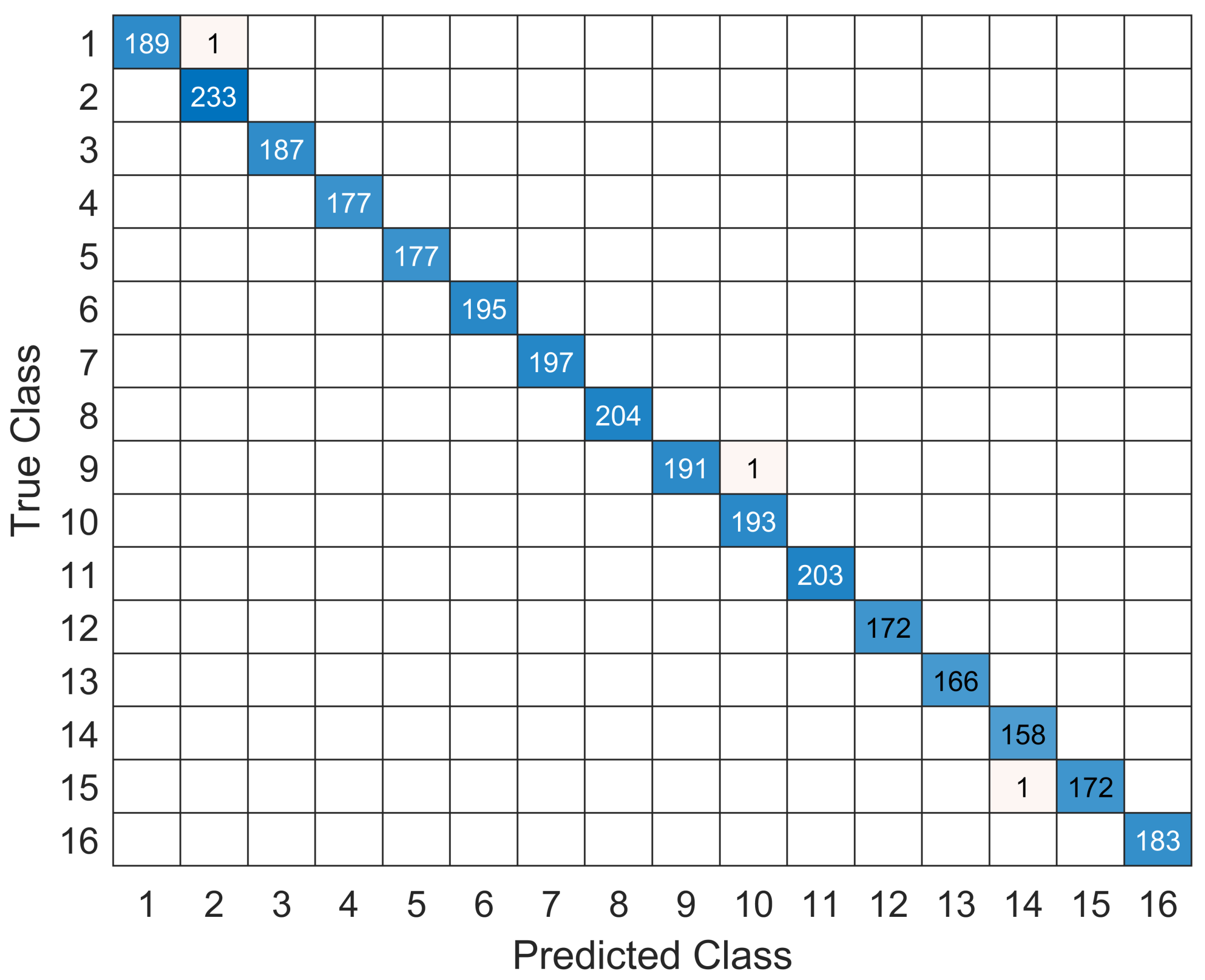




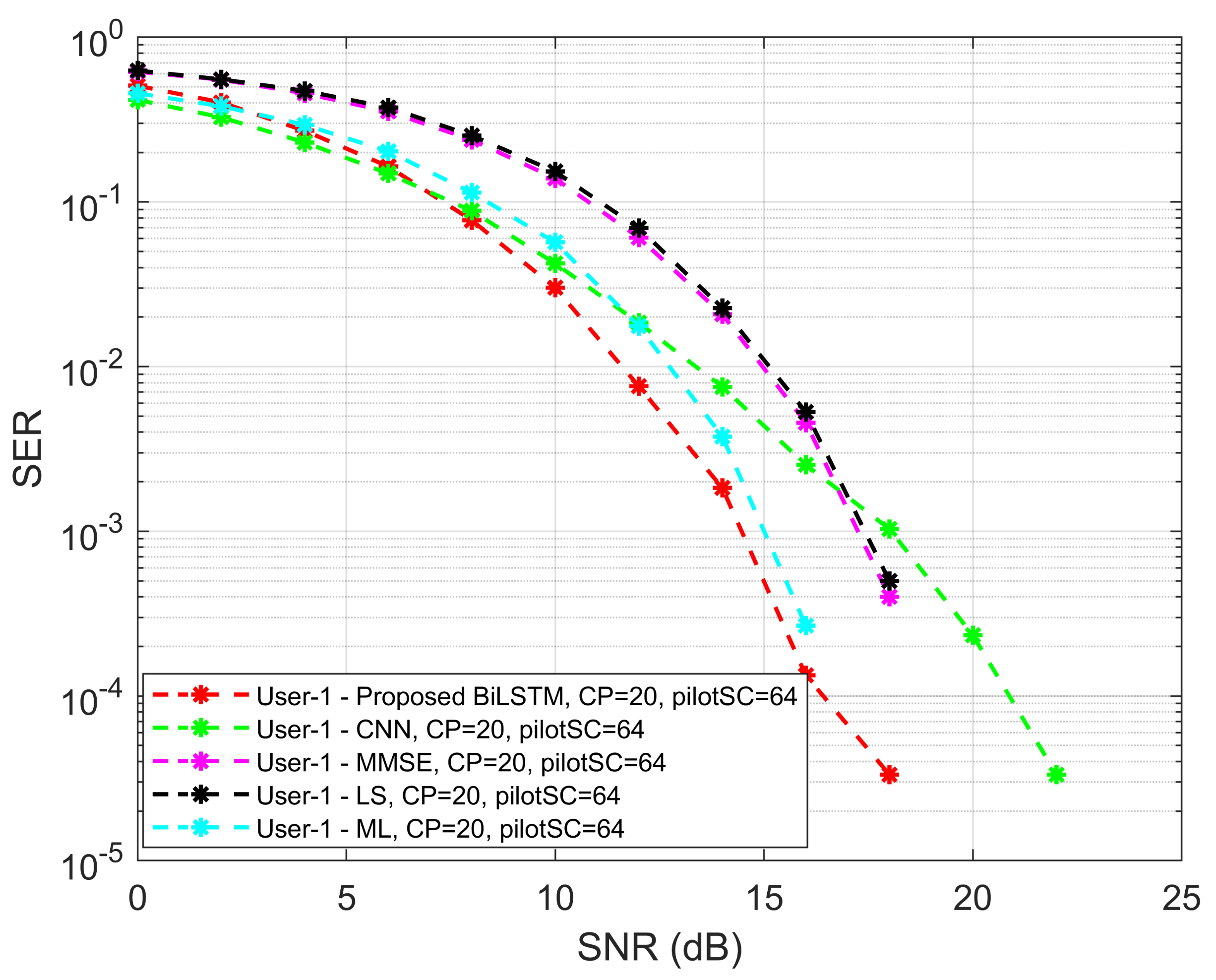
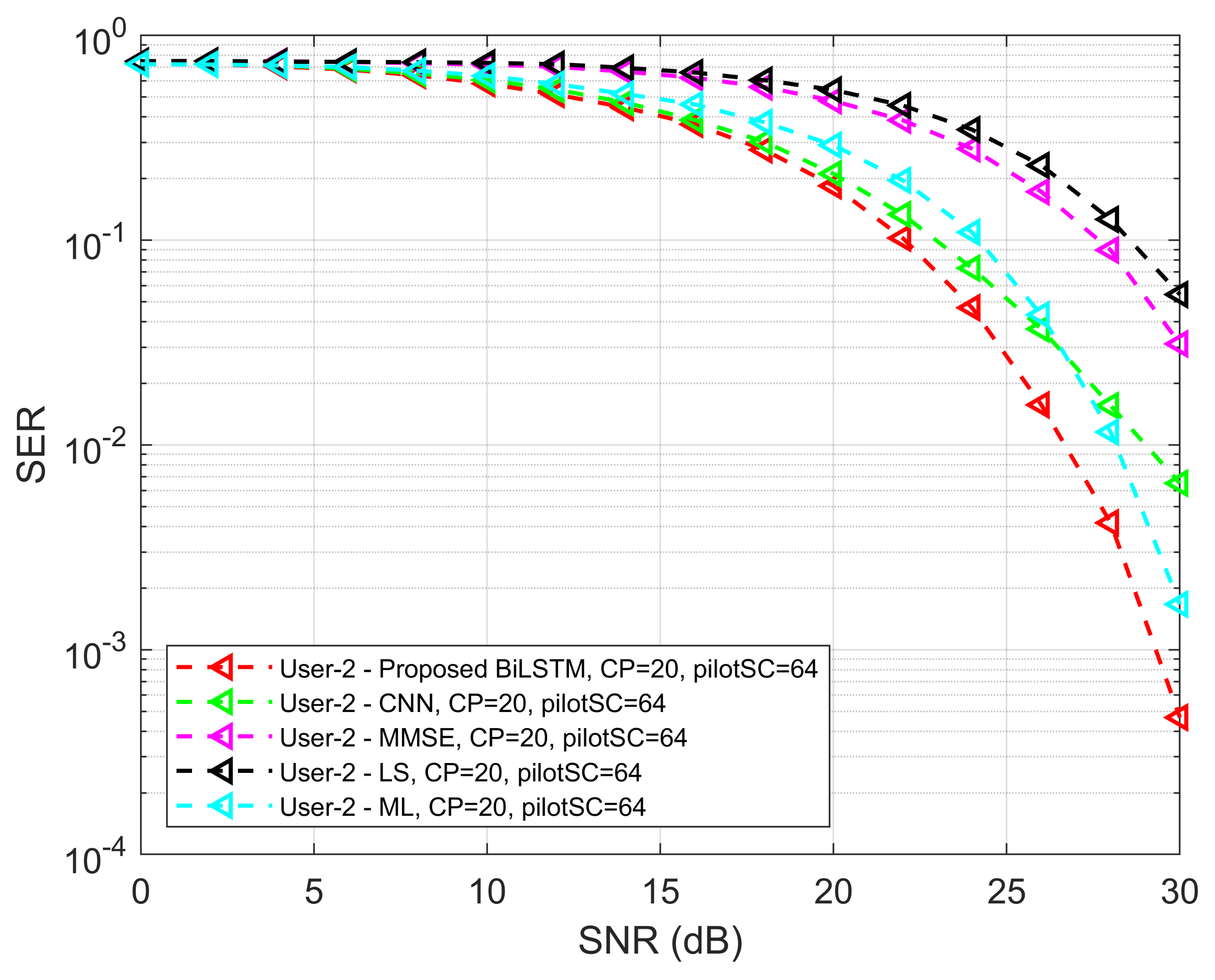
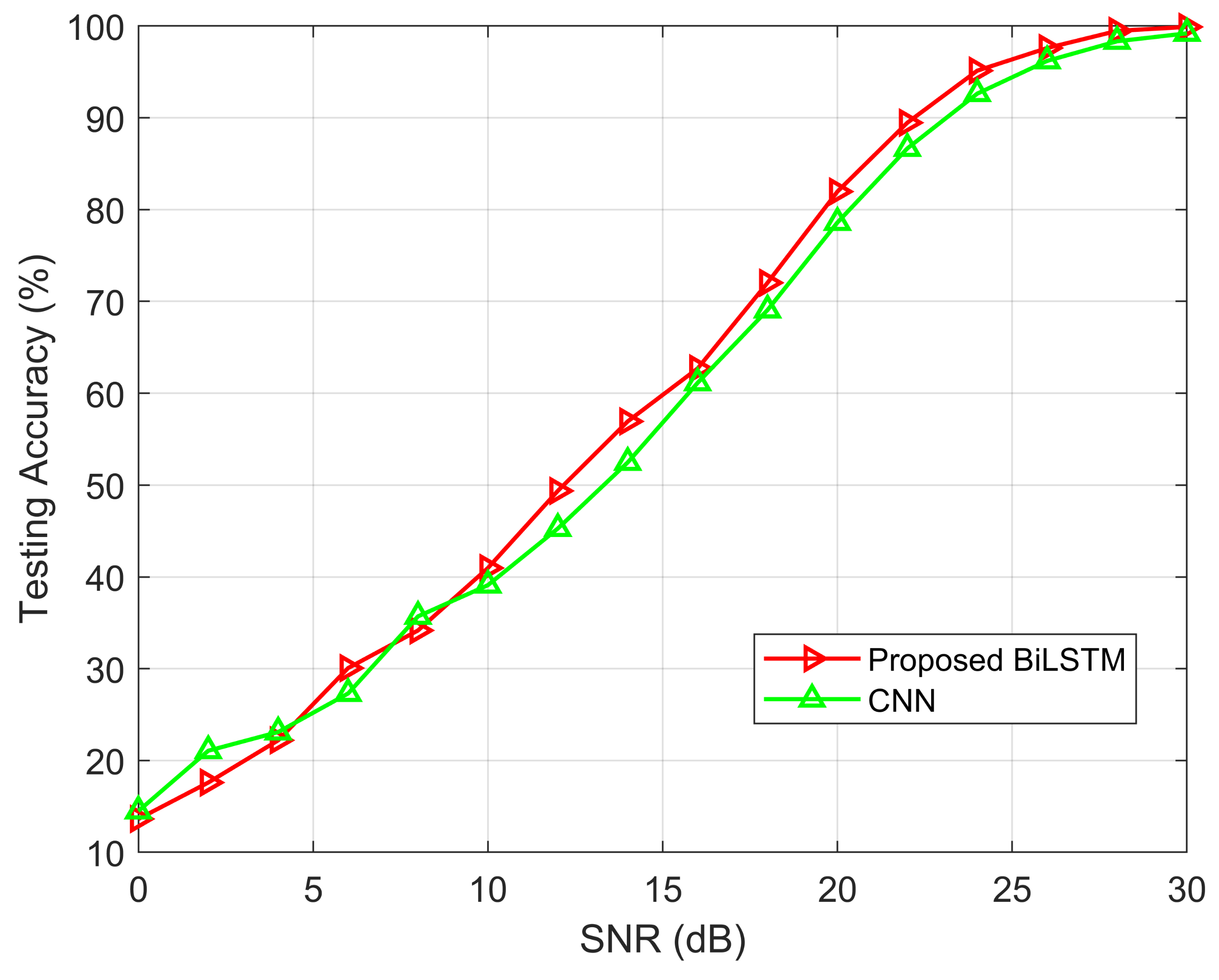
| Parameter | Value |
|---|---|
| Simulation tool | MATLAB Deep-learning toolboxTM |
| Operating system | Windows 10 Pro |
| OFDM subcarriers | 64 |
| Pilot symbols | 64 |
| Channel path | 20 |
| Noise | AWGN |
| Length of CP | 20 |
| Channel fading | Rayleigh channel |
| NOMA UEs | 2 |
| Modulation type | QPSK |
| Total number of packets | 50,000 |
| Total model layers | 5 |
| Epochs number | 100 |
| Learning rate | 0.01 |
| Minibatch size | 2000 |
| Optimizer | ADAM |
Publisher’s Note: MDPI stays neutral with regard to jurisdictional claims in published maps and institutional affiliations. |
© 2022 by the authors. Licensee MDPI, Basel, Switzerland. This article is an open access article distributed under the terms and conditions of the Creative Commons Attribution (CC BY) license (https://creativecommons.org/licenses/by/4.0/).
Share and Cite
Rahman, M.H.; Sejan, M.A.S.; Yoo, S.-G.; Kim, M.-A.; You, Y.-H.; Song, H.-K. Multi-User Joint Detection Using Bi-Directional Deep Neural Network Framework in NOMA-OFDM System. Sensors 2022, 22, 6994. https://doi.org/10.3390/s22186994
Rahman MH, Sejan MAS, Yoo S-G, Kim M-A, You Y-H, Song H-K. Multi-User Joint Detection Using Bi-Directional Deep Neural Network Framework in NOMA-OFDM System. Sensors. 2022; 22(18):6994. https://doi.org/10.3390/s22186994
Chicago/Turabian StyleRahman, Md Habibur, Mohammad Abrar Shakil Sejan, Seung-Geun Yoo, Min-A Kim, Young-Hwan You, and Hyoung-Kyu Song. 2022. "Multi-User Joint Detection Using Bi-Directional Deep Neural Network Framework in NOMA-OFDM System" Sensors 22, no. 18: 6994. https://doi.org/10.3390/s22186994
APA StyleRahman, M. H., Sejan, M. A. S., Yoo, S.-G., Kim, M.-A., You, Y.-H., & Song, H.-K. (2022). Multi-User Joint Detection Using Bi-Directional Deep Neural Network Framework in NOMA-OFDM System. Sensors, 22(18), 6994. https://doi.org/10.3390/s22186994







